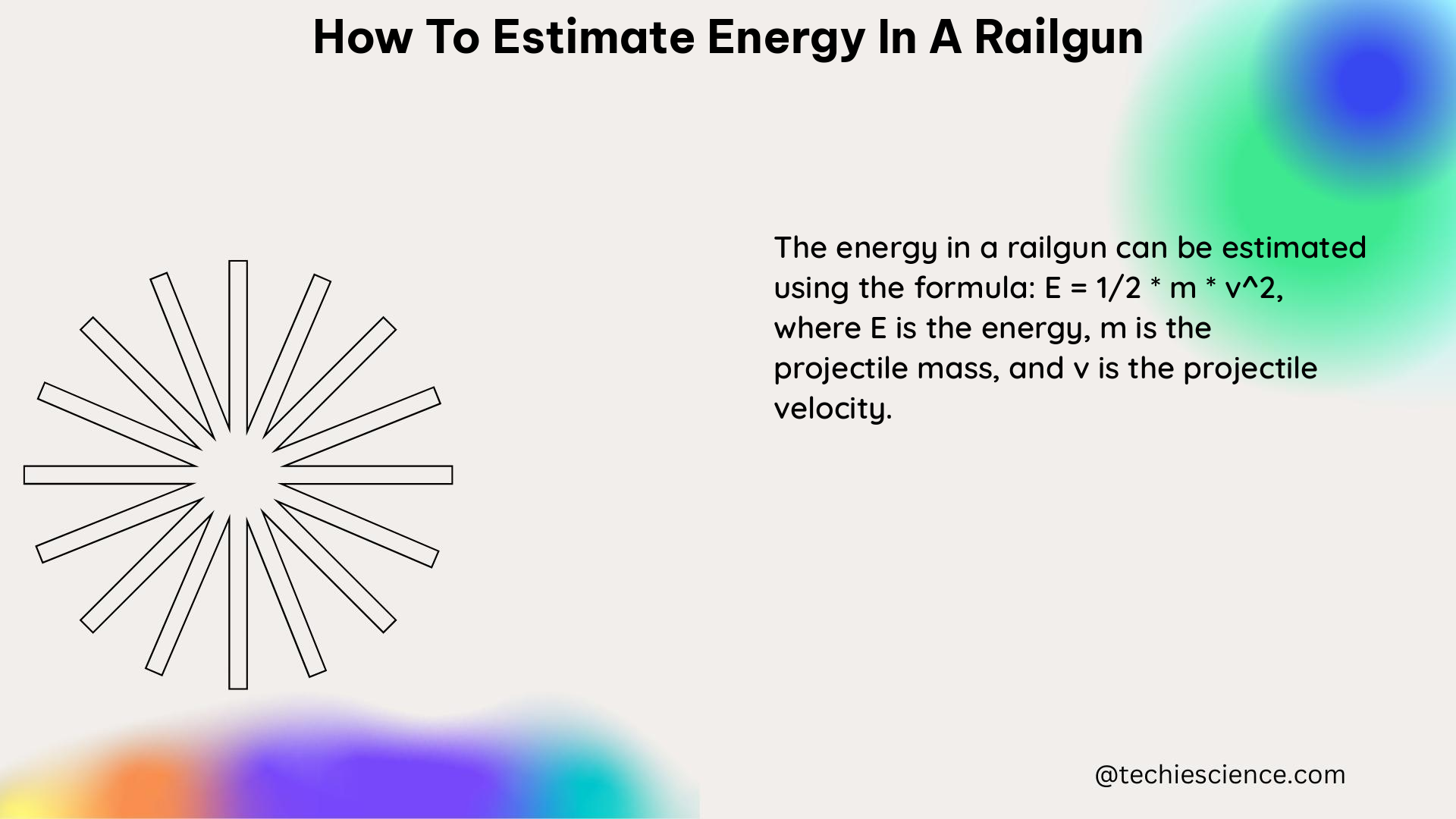Summary
Estimating the energy required for a railgun’s operation involves considering various factors, including the magnetic energy of the flux, resistive heating of the rails, voltage drop across the projectile, friction and windage, and the energy needed to accelerate the plasma. This comprehensive guide delves into the formulas, calculations, and practical examples to help you accurately estimate the energy requirements for your railgun design.
Magnetic Energy of the Flux

The magnetic energy stored in the rails of a railgun can be calculated using the formula:
E_mag = 0.5 * L * I^2
where:
– E_mag is the magnetic energy (in Joules)
– L is the inductance of the rails (in Henries)
– I is the current flowing through the rails (in Amperes)
The inductance of the rails can be determined using the formula:
L = μ_0 * (l/A)
where:
– μ_0 is the permeability of free space (4π × 10^-7 H/m)
– l is the length of the rails (in meters)
– A is the cross-sectional area of the rails (in square meters)
For example, if we have a railgun with:
– Inductance L = 0.1 H
– Current I = 100,000 A
Then, the magnetic energy stored in the rails can be calculated as:
E_mag = 0.5 * 0.1 * (100,000)^2 = 5 MJ
Resistive Heating of the Rails
The resistive heating of the rails can be estimated using the formula:
E_resistive = I^2 * R * t
where:
– E_resistive is the resistive heating energy (in Joules)
– I is the current flowing through the rails (in Amperes)
– R is the resistance of the rails (in Ohms)
– t is the time for which the current flows (in seconds)
For example, if we have a railgun with:
– Current I = 100,000 A
– Resistance R = 0.01 Ω
– Time t = 0.001 s (1 millisecond)
Then, the resistive heating of the rails can be calculated as:
E_resistive = (100,000)^2 * 0.01 * 0.001 = 100 J
Voltage Drop and Energy Transfer to the Projectile
The voltage drop across the projectile (or plasma) can be measured using a voltage probe placed at the muzzle of the railgun. The energy transferred to the projectile can then be calculated as:
E_projectile = V * t
where:
– E_projectile is the energy transferred to the projectile (in Joules)
– V is the voltage drop across the projectile (in Volts)
– t is the time for which the projectile is accelerated (in seconds)
For example, if we have a railgun with:
– Voltage drop V = 10,000 V
– Time t = 0.001 s (1 millisecond)
Then, the energy transferred to the projectile can be calculated as:
E_projectile = 10,000 * 0.001 = 10 J
Friction and Windage Losses
The friction and windage losses can be estimated by measuring the force required to move the projectile through the air and subtracting the force due to gravity. This can be done experimentally or through computational fluid dynamics (CFD) simulations.
Energy Required to Accelerate the Plasma
The energy required to accelerate the plasma can be estimated using the formula:
E_plasma = 0.5 * m * v^2
where:
– E_plasma is the energy required to accelerate the plasma (in Joules)
– m is the mass of the plasma (in kilograms)
– v is the velocity of the plasma (in meters per second)
For example, if we have a railgun with:
– Plasma mass m = 0.001 kg (1 gram)
– Plasma velocity v = 1,000 m/s
Then, the energy required to accelerate the plasma can be calculated as:
E_plasma = 0.5 * 0.001 * (1,000)^2 = 0.5 J
Total Energy Estimation
To calculate the total energy required for railgun operation, we need to sum up all the individual energy components:
E_total = E_mag + E_resistive + E_projectile + E_plasma
Using the example values from the previous sections, the total energy required for railgun operation can be estimated as:
E_total = 5 MJ + 100 J + 10 J + 0.5 J = 5.0105 MJ
It’s important to note that these calculations are based on several assumptions and approximations, and the actual energy requirements may vary depending on the specific design and operating conditions of the railgun. Additionally, other factors, such as energy losses in the power supply and switching systems, may need to be considered for a more comprehensive analysis.
Conclusion
Estimating the energy required for a railgun’s operation is a crucial step in the design and development process. By understanding the various factors involved, such as magnetic energy, resistive heating, voltage drop, friction and windage, and plasma acceleration, you can accurately calculate the total energy requirements for your railgun. This comprehensive guide provides the necessary formulas, examples, and practical considerations to help you master the art of energy estimation in railgun technology.
References
- Worldbuilding Stack Exchange: How much energy would I require for a railgun to shot a bullet in the same speed?
- Princeton University: Railgun Example
- Texas Tech University: Railgun Design and Modeling
- DTIC: Railgun Modeling and Simulation

The lambdageeks.com Core SME Team is a group of experienced subject matter experts from diverse scientific and technical fields including Physics, Chemistry, Technology,Electronics & Electrical Engineering, Automotive, Mechanical Engineering. Our team collaborates to create high-quality, well-researched articles on a wide range of science and technology topics for the lambdageeks.com website.
All Our Senior SME are having more than 7 Years of experience in the respective fields . They are either Working Industry Professionals or assocaited With different Universities. Refer Our Authors Page to get to know About our Core SMEs.